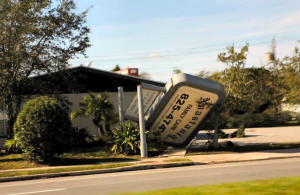|
Coastal Florida cleans up wreckage of
powerful storm Matthew
 Send a link to a friend
Send a link to a friend
 [October 10, 2016]
By Scott Malone [October 10, 2016]
By Scott Malone
ST. AUGUSTINE, Fla. (Reuters) - Joan
Galasso walked through the empty wreck of the waterfront seafood
restaurant she and her husband started a quarter-century ago and was
horrified.
Hurricane Matthew had ripped away the deck where tourists had gathered
to eat, drink and watch the sun set. It had smashed through the windows
and shoved one of the dining booths into the kitchen.
"It looks like a war zone," Galasso, 63, said of her restaurant,
Matanzas Innlet, located about 15 miles south of St. Augustine. "It's a
total loss."
Galasso was one of millions of residents of the U.S. southeastern coast
returning to homes and businesses hammered by the storm.
Matthew was a Category 5 hurricane, the most powerful classification of
storm, at its peak but was downgraded to a post-tropical cyclone on
Sunday as it headed away from the North Carolina coast. It killed at
least 11 people in the United States and close to 900 in Haiti.
Officials in Florida, Georgia, South Carolina and North Carolina had
urged people along parts of a 600-mile stretch of coast to evacuate.
Some 2 million people were without power and streets were darkened miles
from the coast.

Long lines of cars snaked along the roads leading to Florida's barrier
islands, which bore the storm's brunt, after police began to let
residents back across.
'IT'S HEARTBREAKING'
Barry Fauts, 72, came back to find his property in coastal St. Augustine
shattered by the storm.
"It's heartbreaking," he said as he looked at the jagged mess of
shattered wood that had once been a 2,000-square-foot ocean-facing deck
attached to his two rental units. Fauts, who is retired, bought the
property five years ago to rent to vacationers.
"We had people in here when the hurricane came so we refunded their
money and they left," Fauts said. "I was looking at coming back with
chainsaw and a dump trailer. But this is probably more than I can
handle. I guess the next step is call my insurance agent."
[to top of second column] |

A damaged sign is seen on St. Augustine Beach in the aftermath of
Hurricane Matthew, Florida, U.S. October 9, 2016. REUTERS/Henry
Romero

CoreLogic, a real estate data firm, estimated the storm may have
caused up to $800 billion in damage to property along the U.S.
coast.
Farther south police and National Guard troops still had the main
road closed, saying the road was impassable.
On St. Augustine Beach, streets were clogged with tree limbs and
power lines. Residents trickling back in assessed their homes and
began to clear their property.
Elyse Deluca, a 30-year-old nurse, said she had evacuated to
Tennessee, unable to find a closer hotel room.
"We really wanted to get back. We were worried about this house,
what we would see," she said after seeing her home for the first
time in three days. Tree branches littered her property but the home
itself was undamaged.
"We had water about halfway across the lawn but none got into the
house," she said.
(Editing by Frank McGurty and Bill Trott)
[© 2016 Thomson Reuters. All rights
reserved.]
Copyright 2016 Reuters. All rights reserved. This material may not be published,
broadcast, rewritten or redistributed.
 |